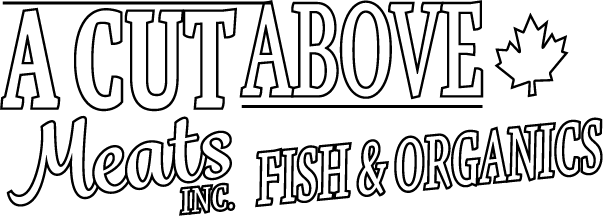Wild Sockeye Salmon
What's so great about our sockeye salmon?
If you care about your health (or if you want to embody the energy of a mighty grizzly bear) then sockeye salmon is the fish for you!This popular and uber-delicious fish will supply you with many nutrients necessary to keep you strong and healthy. However, with the rise of environmental toxins and chemical preservatives, many are rightfully concerned with whether these fish are actually good for you.
So join us as we break down the health benefits and risks of sockeye salmon, and what you can expect from A Cut Above Meats' fish.
Nothing fishy about salmon's health benefits
First off, there is no question that salmon is a healthy food. One three-ounce serving of salmon provides 121 calories, 17g of protein, 5.4g of fat and 37.4mg of sodium. Plus, there is no sugar or carbs to be found! This fish contains essential vitamins and nutrients like omega-3 fatty acids, vitamin B12, selenium, and niacin. High intake of Omega-3 fatty acids, in particular, is associated with a reduced risk of cardiovascular disease and Alzheimer’s. If you're deficient in Vitamin D (and you probably are, my fellow Canuck!), you'll also want to chow down on Salmon. Three and a half ounces of wild-caught salmon will provide 556–924 IU of vitamin D, which is 70–111% of the daily recommended value. Salmon provides your body with all the building blocks needed to keep your heart, eyes, brain and immune system functioning optimally. It's just one of nature's many multivitamins!
Mulling over the mercury content
However, many people are anxious about harmful chemicals found in fish. For example, mercury from human activities can make its way into the water and be absorbed by fish. Exposure to high levels of mercury has been found to negatively impact humans' nervous systems, brains, and hearts, and harm the development of children. However, salmon are less likely than other fish to contain mercury. Fish that are higher up on the food chain, such as tuna, swordfish, and mackerel, tend to have the highest mercury concentrations, as they've accumulated it through eating smaller fish that have already consumed mercury. Because sockeye salmon are smaller, shorter-lived fish that are lower on the food chain, they contain much less mercury - especially when they are wild-caught. According to data from the United States Food and Drug Administration, sockeye salmon has a mercury concentration of 0.0014 parts per million, while swordfish has 0.995 ppm and albacore tuna has 0.354 ppm.
What the Fish are PCBs?
Polychlorinated Biphenyls (PCBs), found in many fish, are also a risk to human health. PCBs refer to any of the 209 toxic chemicals that were used in manufacturing long ago, but have since been banned in North America. PCBs were found to cause cancer, disrupt endocrine systems, harm the liver, and weaken immune systems. Despite the 1977 ban, PCBs can still be found in the environment, where fish absorb them. But similar to mercury, fish higher up the food chain tend to absorb more PCBs. While swordfish have PCB concentrations of 1.4 ppm and tuna have 0.6 ppm, sockeye salmon have just 0.1 ppm. It's clear that when it comes to nutritious fish that don't contain toxic chemicals, sockeye salmon is the top choice.
Preservatives harm your health (and wallet)
But not so fast - the toxic chemicals don't stop once the fish has been caught. In many cases, chemicals called triphosphates are added to fish to preserve them. The seafood you buy in grocery stores may look pristine and natural, but a chemical called sodium tripolyphosphate (STPP) is often added to it to make it appear firmer, smoother and glossier. Unfortunately, STPP is also associated with several health concerns. STPP can accumulate in the kidneys and damage them over time. It binds to calcium in the body and reduces its availability, which is associated with weak bones and osteoporosis. And studies have suggested that high levels of STPP consumption lead to an increased risk of heart disease. Not only is STPP bad for your health, but it's also bad for your wallet. If seafood is soaked STPP "bath" for too long, it may absorb more water. This extra weight means you'll pay more for a product by the pound. Not ideal at a time when inflation is at a 40-year high! A good way to tell if a seafood product has been "soaked" with STPP is if a milky white liquid oozes out of the fish when you cook it. Fish that has been contaminated with STPP will also deflate in size a bit as you cook it.
A Cut Above Meats doesn't play around
All our fresh and farmed seafood has been certified by the Best Aquacultural Practices and the Marine Stewardship Council, meaning it is well-managed, sustainable and safe. We refuse to compromise on quality for our customers, even if it means some extra work. So if you want fresh Pacific or farmed Atlantic salmon, then A Cut Above Meats is one of the best choices out there. If salmon isn't for you, we also sell cod, pickerel, halibut, haddock, scallops and more.
